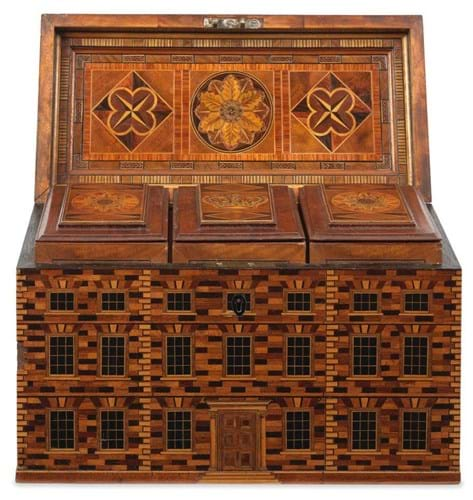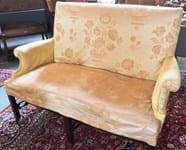It made one of the highest prices of the day in selling at £30,000, double the £12,000-18,000 guide.
The caddy, which measures 10in (25.5cm) wide x 6in (16.5cm) high x 4½in (12.5cm) deep and dates from c.1785, is, like many of the most desirable examples of this period, architectural in form, inlaid and veneered as a brick-built Georgian house with steps leading to a columned portico to the front and back.
The inlays comprise marquetry and parquetry in a range of exotic woods including mahogany, harewood, ebony, purplewood, rosewood and fruitwood.
The lid, which features overlapping lozenges and a roundel inset with a compass star, lifts to reveal three hinged lidded lead lined canisters inscribed respectively LM and R to the undersides with lids similarly inlaid while the centre lid also features a crown.
Highly detailed architectural-style caddies were popular in the late 18th and early 19th century. Most were made in the form of generic Palladian villas or townhouses but it is possible some were specific commissions copying the owner’s residence.
Prince Regent’s home
The best known of these is a caddy dating from 1786 modelled on Carlton House (then the London home of the Prince Regent, designed by the architect Henry Holland) which is now in the collection of the Museum of London.
The caddy was made by the cabinetmaker William Potter of Cornhill and features fully signed inset mother of pearl discs bearing Potter’s name and the date of manufacture, presumably as a form of self promotion. It was sent by its maker to George III for his inspection then subsequently raffled with 50 subscribers paying two guineas each.
The subscribers included prominent aristocrats and figures of the day including Prince Augustus Frederick, the dukes of York, Queensberry and Cornwall and Lord Nelson’s mistress Lady Hamilton. However, ironically the caddy was won by Potter himself who had purchased several tickets.
The Carlton House/Museum of London caddy features particularly fine inner tea cannisters which are also are inlaid with architectural detail and windows so that when they are removed from the caddy they become subsidiary pavilions flanking the main house.
Bonhams’ caddy, which was offered at the auction on July 12, has been attributed to Potter on the basis of its close resemblance to the Museum of London example and although its cannister exteriors are plainer, the crown motif inlaid to the central lid does suggest that it many have been commissioned from Potter by an aristocratic supporter of George III.
















